PUBH641: Humanitarian Assistance and Health Reflection Essay
VerifiedAdded on 2023/06/11
|5
|1168
|269
Essay
AI Summary
This essay presents a student's reflection on the principles and global architecture of health and humanitarian assistance. It emphasizes the importance of independence, neutrality, humanity, and impartiality in humanitarian work. The reflection highlights the roles of various actors, including governmental and non-governmental organizations, particularly the Australian government's Department of Foreign Affairs and Trade (DFAT), in responding to international crises. The essay also discusses the significance of local actors in disaster response and the importance of coordination and collaboration among all stakeholders. The student reflects on how this knowledge can be applied in their future practice as a health practitioner to ensure quality care and patient safety during humanitarian efforts.
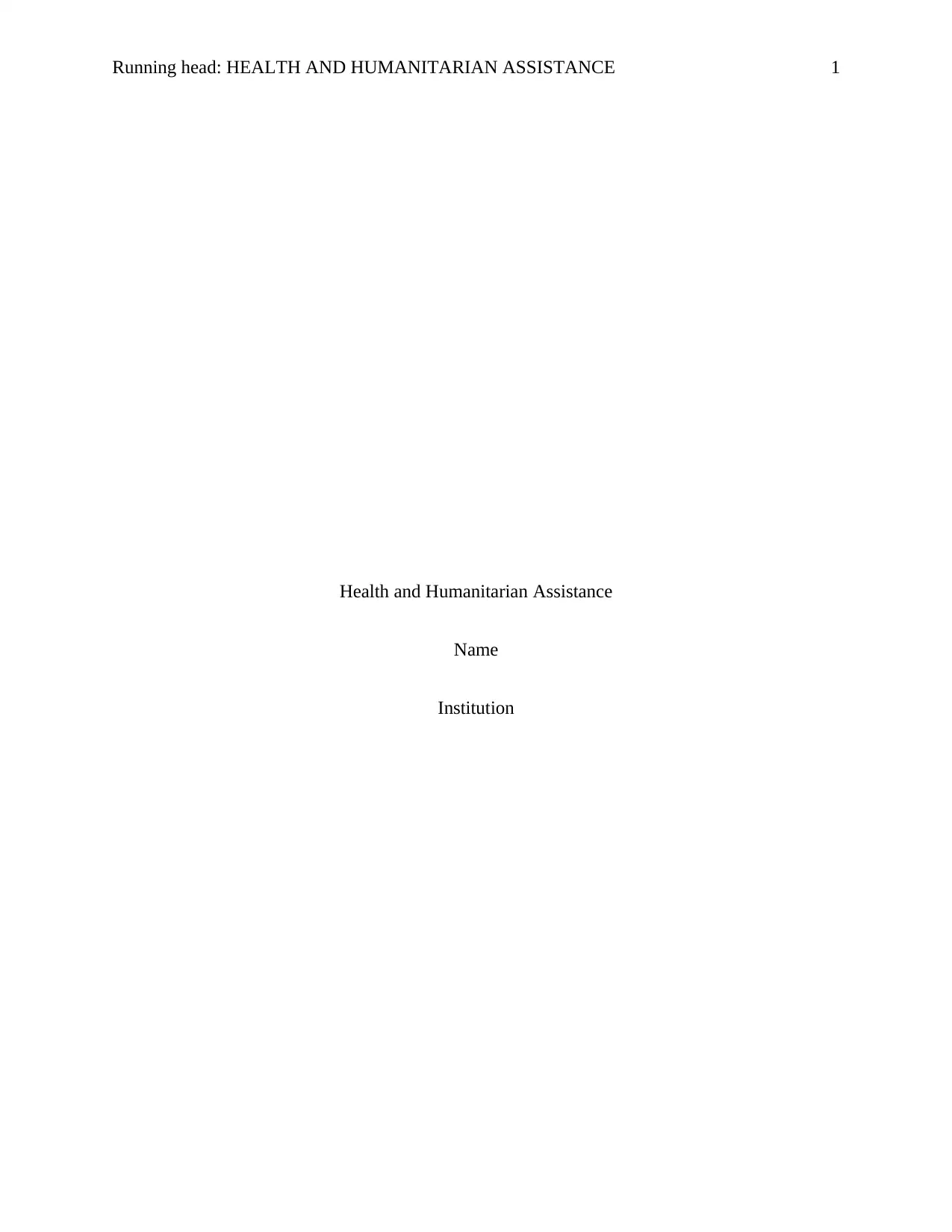
Running head: HEALTH AND HUMANITARIAN ASSISTANCE 1
Health and Humanitarian Assistance
Name
Institution
Health and Humanitarian Assistance
Name
Institution
Paraphrase This Document
Need a fresh take? Get an instant paraphrase of this document with our AI Paraphraser
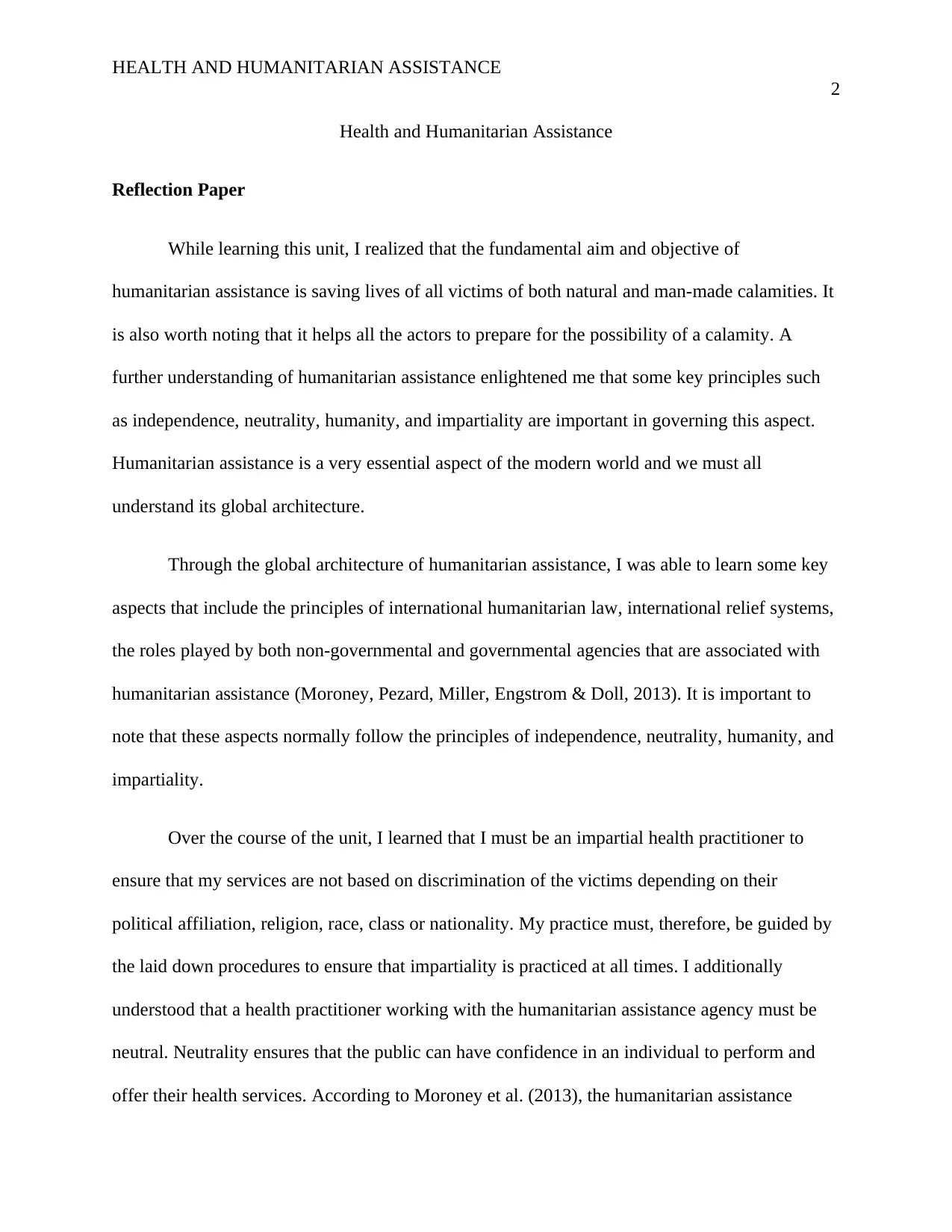
HEALTH AND HUMANITARIAN ASSISTANCE
2
Health and Humanitarian Assistance
Reflection Paper
While learning this unit, I realized that the fundamental aim and objective of
humanitarian assistance is saving lives of all victims of both natural and man-made calamities. It
is also worth noting that it helps all the actors to prepare for the possibility of a calamity. A
further understanding of humanitarian assistance enlightened me that some key principles such
as independence, neutrality, humanity, and impartiality are important in governing this aspect.
Humanitarian assistance is a very essential aspect of the modern world and we must all
understand its global architecture.
Through the global architecture of humanitarian assistance, I was able to learn some key
aspects that include the principles of international humanitarian law, international relief systems,
the roles played by both non-governmental and governmental agencies that are associated with
humanitarian assistance (Moroney, Pezard, Miller, Engstrom & Doll, 2013). It is important to
note that these aspects normally follow the principles of independence, neutrality, humanity, and
impartiality.
Over the course of the unit, I learned that I must be an impartial health practitioner to
ensure that my services are not based on discrimination of the victims depending on their
political affiliation, religion, race, class or nationality. My practice must, therefore, be guided by
the laid down procedures to ensure that impartiality is practiced at all times. I additionally
understood that a health practitioner working with the humanitarian assistance agency must be
neutral. Neutrality ensures that the public can have confidence in an individual to perform and
offer their health services. According to Moroney et al. (2013), the humanitarian assistance
2
Health and Humanitarian Assistance
Reflection Paper
While learning this unit, I realized that the fundamental aim and objective of
humanitarian assistance is saving lives of all victims of both natural and man-made calamities. It
is also worth noting that it helps all the actors to prepare for the possibility of a calamity. A
further understanding of humanitarian assistance enlightened me that some key principles such
as independence, neutrality, humanity, and impartiality are important in governing this aspect.
Humanitarian assistance is a very essential aspect of the modern world and we must all
understand its global architecture.
Through the global architecture of humanitarian assistance, I was able to learn some key
aspects that include the principles of international humanitarian law, international relief systems,
the roles played by both non-governmental and governmental agencies that are associated with
humanitarian assistance (Moroney, Pezard, Miller, Engstrom & Doll, 2013). It is important to
note that these aspects normally follow the principles of independence, neutrality, humanity, and
impartiality.
Over the course of the unit, I learned that I must be an impartial health practitioner to
ensure that my services are not based on discrimination of the victims depending on their
political affiliation, religion, race, class or nationality. My practice must, therefore, be guided by
the laid down procedures to ensure that impartiality is practiced at all times. I additionally
understood that a health practitioner working with the humanitarian assistance agency must be
neutral. Neutrality ensures that the public can have confidence in an individual to perform and
offer their health services. According to Moroney et al. (2013), the humanitarian assistance
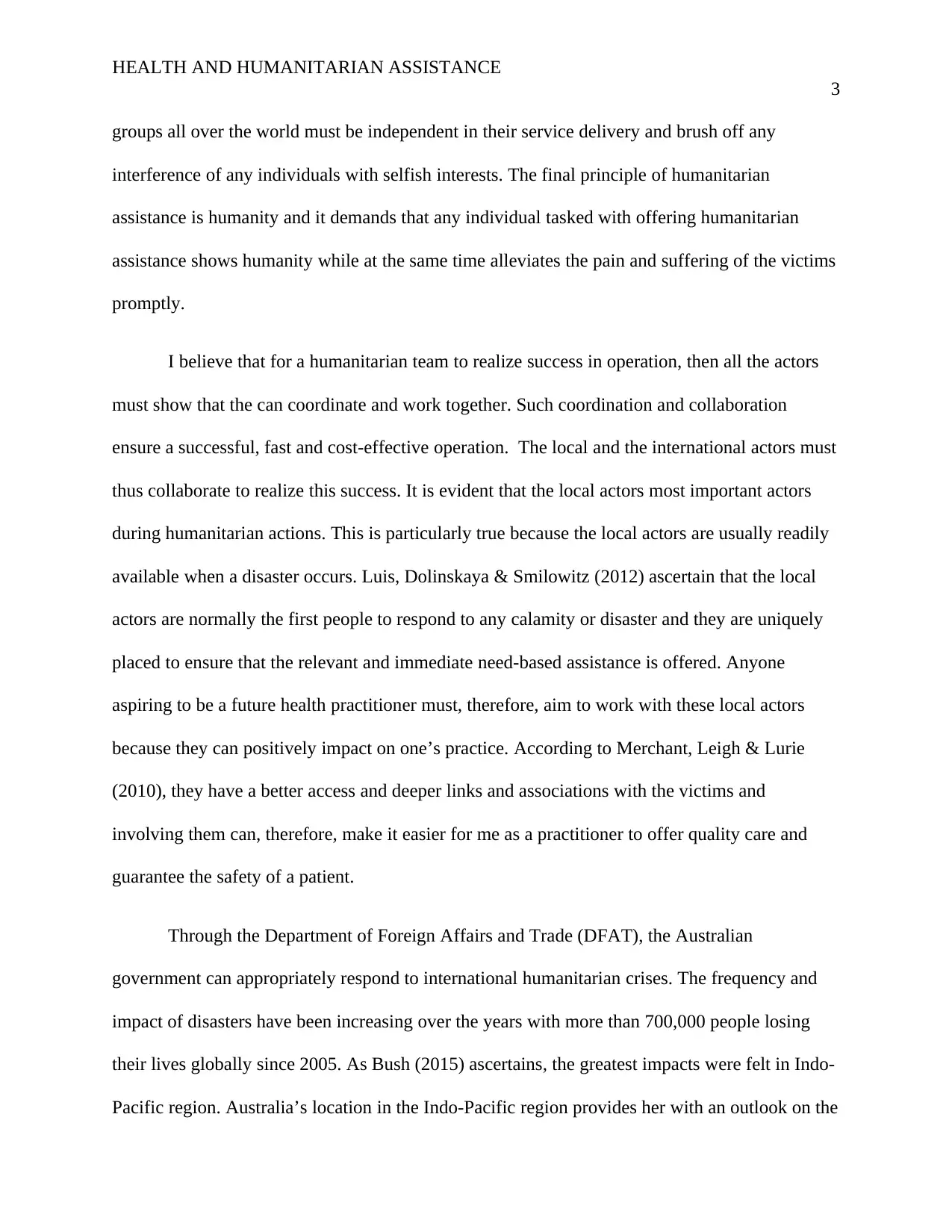
HEALTH AND HUMANITARIAN ASSISTANCE
3
groups all over the world must be independent in their service delivery and brush off any
interference of any individuals with selfish interests. The final principle of humanitarian
assistance is humanity and it demands that any individual tasked with offering humanitarian
assistance shows humanity while at the same time alleviates the pain and suffering of the victims
promptly.
I believe that for a humanitarian team to realize success in operation, then all the actors
must show that the can coordinate and work together. Such coordination and collaboration
ensure a successful, fast and cost-effective operation. The local and the international actors must
thus collaborate to realize this success. It is evident that the local actors most important actors
during humanitarian actions. This is particularly true because the local actors are usually readily
available when a disaster occurs. Luis, Dolinskaya & Smilowitz (2012) ascertain that the local
actors are normally the first people to respond to any calamity or disaster and they are uniquely
placed to ensure that the relevant and immediate need-based assistance is offered. Anyone
aspiring to be a future health practitioner must, therefore, aim to work with these local actors
because they can positively impact on one’s practice. According to Merchant, Leigh & Lurie
(2010), they have a better access and deeper links and associations with the victims and
involving them can, therefore, make it easier for me as a practitioner to offer quality care and
guarantee the safety of a patient.
Through the Department of Foreign Affairs and Trade (DFAT), the Australian
government can appropriately respond to international humanitarian crises. The frequency and
impact of disasters have been increasing over the years with more than 700,000 people losing
their lives globally since 2005. As Bush (2015) ascertains, the greatest impacts were felt in Indo-
Pacific region. Australia’s location in the Indo-Pacific region provides her with an outlook on the
3
groups all over the world must be independent in their service delivery and brush off any
interference of any individuals with selfish interests. The final principle of humanitarian
assistance is humanity and it demands that any individual tasked with offering humanitarian
assistance shows humanity while at the same time alleviates the pain and suffering of the victims
promptly.
I believe that for a humanitarian team to realize success in operation, then all the actors
must show that the can coordinate and work together. Such coordination and collaboration
ensure a successful, fast and cost-effective operation. The local and the international actors must
thus collaborate to realize this success. It is evident that the local actors most important actors
during humanitarian actions. This is particularly true because the local actors are usually readily
available when a disaster occurs. Luis, Dolinskaya & Smilowitz (2012) ascertain that the local
actors are normally the first people to respond to any calamity or disaster and they are uniquely
placed to ensure that the relevant and immediate need-based assistance is offered. Anyone
aspiring to be a future health practitioner must, therefore, aim to work with these local actors
because they can positively impact on one’s practice. According to Merchant, Leigh & Lurie
(2010), they have a better access and deeper links and associations with the victims and
involving them can, therefore, make it easier for me as a practitioner to offer quality care and
guarantee the safety of a patient.
Through the Department of Foreign Affairs and Trade (DFAT), the Australian
government can appropriately respond to international humanitarian crises. The frequency and
impact of disasters have been increasing over the years with more than 700,000 people losing
their lives globally since 2005. As Bush (2015) ascertains, the greatest impacts were felt in Indo-
Pacific region. Australia’s location in the Indo-Pacific region provides her with an outlook on the
⊘ This is a preview!⊘
Do you want full access?
Subscribe today to unlock all pages.

Trusted by 1+ million students worldwide
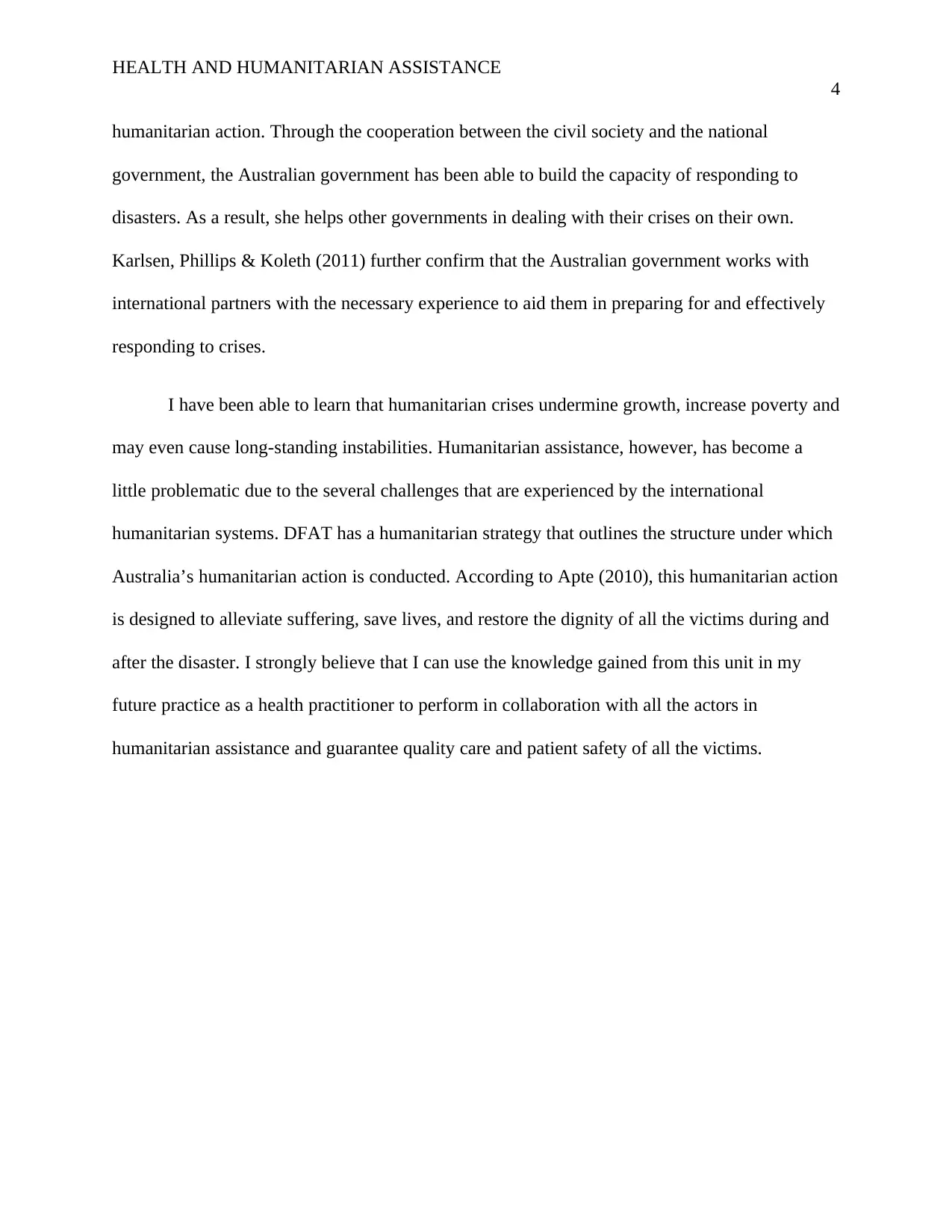
HEALTH AND HUMANITARIAN ASSISTANCE
4
humanitarian action. Through the cooperation between the civil society and the national
government, the Australian government has been able to build the capacity of responding to
disasters. As a result, she helps other governments in dealing with their crises on their own.
Karlsen, Phillips & Koleth (2011) further confirm that the Australian government works with
international partners with the necessary experience to aid them in preparing for and effectively
responding to crises.
I have been able to learn that humanitarian crises undermine growth, increase poverty and
may even cause long-standing instabilities. Humanitarian assistance, however, has become a
little problematic due to the several challenges that are experienced by the international
humanitarian systems. DFAT has a humanitarian strategy that outlines the structure under which
Australia’s humanitarian action is conducted. According to Apte (2010), this humanitarian action
is designed to alleviate suffering, save lives, and restore the dignity of all the victims during and
after the disaster. I strongly believe that I can use the knowledge gained from this unit in my
future practice as a health practitioner to perform in collaboration with all the actors in
humanitarian assistance and guarantee quality care and patient safety of all the victims.
4
humanitarian action. Through the cooperation between the civil society and the national
government, the Australian government has been able to build the capacity of responding to
disasters. As a result, she helps other governments in dealing with their crises on their own.
Karlsen, Phillips & Koleth (2011) further confirm that the Australian government works with
international partners with the necessary experience to aid them in preparing for and effectively
responding to crises.
I have been able to learn that humanitarian crises undermine growth, increase poverty and
may even cause long-standing instabilities. Humanitarian assistance, however, has become a
little problematic due to the several challenges that are experienced by the international
humanitarian systems. DFAT has a humanitarian strategy that outlines the structure under which
Australia’s humanitarian action is conducted. According to Apte (2010), this humanitarian action
is designed to alleviate suffering, save lives, and restore the dignity of all the victims during and
after the disaster. I strongly believe that I can use the knowledge gained from this unit in my
future practice as a health practitioner to perform in collaboration with all the actors in
humanitarian assistance and guarantee quality care and patient safety of all the victims.
Paraphrase This Document
Need a fresh take? Get an instant paraphrase of this document with our AI Paraphraser
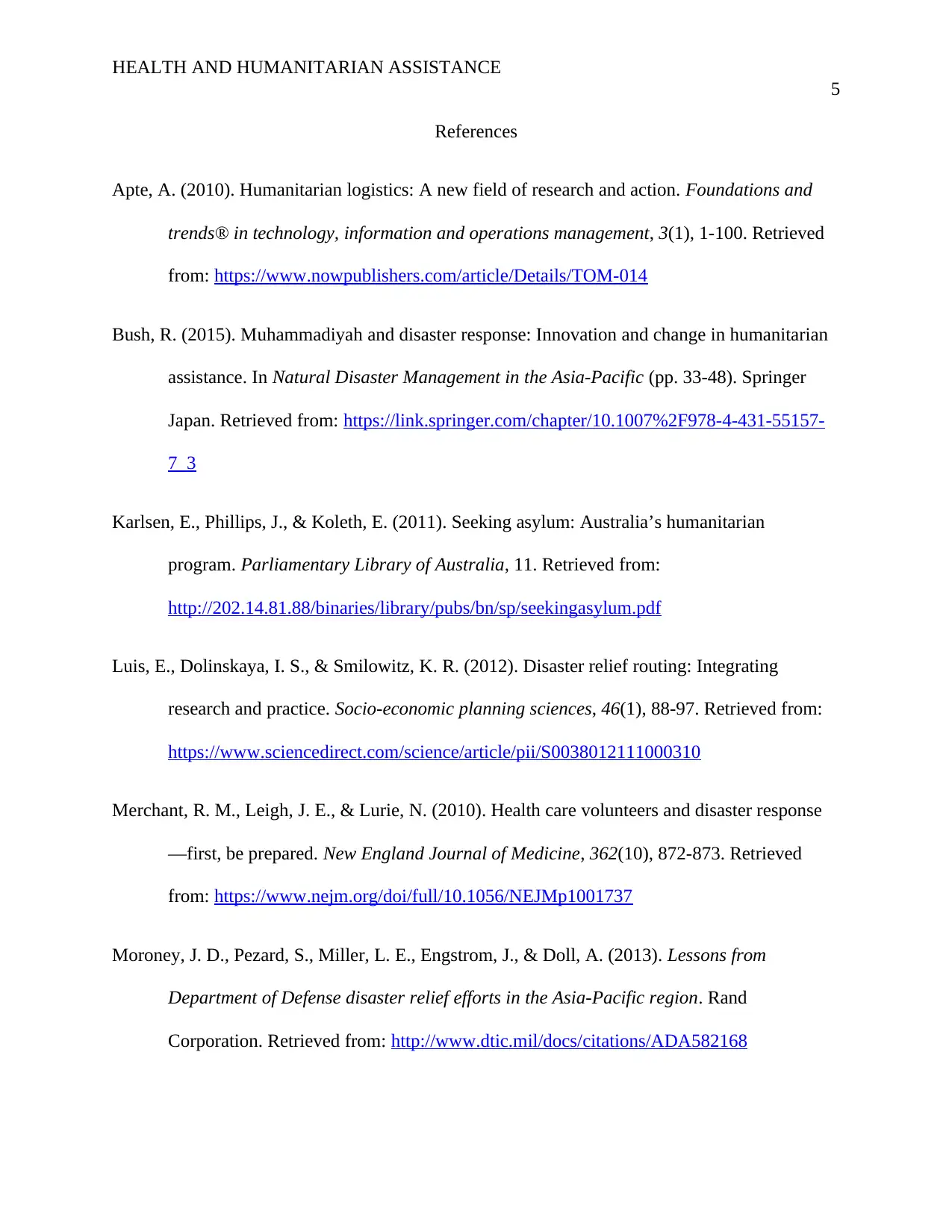
HEALTH AND HUMANITARIAN ASSISTANCE
5
References
Apte, A. (2010). Humanitarian logistics: A new field of research and action. Foundations and
trends® in technology, information and operations management, 3(1), 1-100. Retrieved
from: https://www.nowpublishers.com/article/Details/TOM-014
Bush, R. (2015). Muhammadiyah and disaster response: Innovation and change in humanitarian
assistance. In Natural Disaster Management in the Asia-Pacific (pp. 33-48). Springer
Japan. Retrieved from: https://link.springer.com/chapter/10.1007%2F978-4-431-55157-
7_3
Karlsen, E., Phillips, J., & Koleth, E. (2011). Seeking asylum: Australia’s humanitarian
program. Parliamentary Library of Australia, 11. Retrieved from:
http://202.14.81.88/binaries/library/pubs/bn/sp/seekingasylum.pdf
Luis, E., Dolinskaya, I. S., & Smilowitz, K. R. (2012). Disaster relief routing: Integrating
research and practice. Socio-economic planning sciences, 46(1), 88-97. Retrieved from:
https://www.sciencedirect.com/science/article/pii/S0038012111000310
Merchant, R. M., Leigh, J. E., & Lurie, N. (2010). Health care volunteers and disaster response
—first, be prepared. New England Journal of Medicine, 362(10), 872-873. Retrieved
from: https://www.nejm.org/doi/full/10.1056/NEJMp1001737
Moroney, J. D., Pezard, S., Miller, L. E., Engstrom, J., & Doll, A. (2013). Lessons from
Department of Defense disaster relief efforts in the Asia-Pacific region. Rand
Corporation. Retrieved from: http://www.dtic.mil/docs/citations/ADA582168
5
References
Apte, A. (2010). Humanitarian logistics: A new field of research and action. Foundations and
trends® in technology, information and operations management, 3(1), 1-100. Retrieved
from: https://www.nowpublishers.com/article/Details/TOM-014
Bush, R. (2015). Muhammadiyah and disaster response: Innovation and change in humanitarian
assistance. In Natural Disaster Management in the Asia-Pacific (pp. 33-48). Springer
Japan. Retrieved from: https://link.springer.com/chapter/10.1007%2F978-4-431-55157-
7_3
Karlsen, E., Phillips, J., & Koleth, E. (2011). Seeking asylum: Australia’s humanitarian
program. Parliamentary Library of Australia, 11. Retrieved from:
http://202.14.81.88/binaries/library/pubs/bn/sp/seekingasylum.pdf
Luis, E., Dolinskaya, I. S., & Smilowitz, K. R. (2012). Disaster relief routing: Integrating
research and practice. Socio-economic planning sciences, 46(1), 88-97. Retrieved from:
https://www.sciencedirect.com/science/article/pii/S0038012111000310
Merchant, R. M., Leigh, J. E., & Lurie, N. (2010). Health care volunteers and disaster response
—first, be prepared. New England Journal of Medicine, 362(10), 872-873. Retrieved
from: https://www.nejm.org/doi/full/10.1056/NEJMp1001737
Moroney, J. D., Pezard, S., Miller, L. E., Engstrom, J., & Doll, A. (2013). Lessons from
Department of Defense disaster relief efforts in the Asia-Pacific region. Rand
Corporation. Retrieved from: http://www.dtic.mil/docs/citations/ADA582168
1 out of 5
Related Documents
Your All-in-One AI-Powered Toolkit for Academic Success.
+13062052269
info@desklib.com
Available 24*7 on WhatsApp / Email
![[object Object]](/_next/static/media/star-bottom.7253800d.svg)
Unlock your academic potential
Copyright © 2020–2025 A2Z Services. All Rights Reserved. Developed and managed by ZUCOL.





